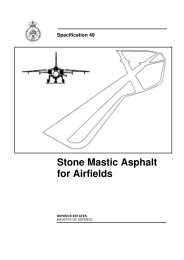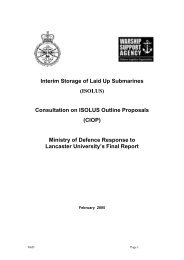Part III - Historical Survey of the Porton Down Service Volunteer ...
Part III - Historical Survey of the Porton Down Service Volunteer ...
Part III - Historical Survey of the Porton Down Service Volunteer ...
Create successful ePaper yourself
Turn your PDF publications into a flip-book with our unique Google optimized e-Paper software.
a. Based on <strong>Porton</strong> work reported in June 1949 [24], it was decided in October<br />
1949 [25, 26] that GA was <strong>of</strong> little value. GD was found to be <strong>the</strong> most toxic <strong>of</strong><br />
<strong>the</strong> G series but was ruled out because <strong>the</strong> raw material (pinacolyl alcohol)<br />
necessary for its production was not available in any quantity. GB was generally<br />
preferable to GE but GF showed some promise as a persistent agent that<br />
attacked through <strong>the</strong> skin and it was decided that it should be examined fur<strong>the</strong>r.<br />
b. A fur<strong>the</strong>r assessment <strong>of</strong> nerve gases published by <strong>Porton</strong> in August 1950 [27]<br />
concluded that, from a toxicological aspect, GB is "in every way superior to" GE<br />
as a chemical warfare agent. GD and GF were found to be highly toxic through<br />
<strong>the</strong> skin but were thought to be <strong>of</strong> too low a volatility to be used in HE/chemical<br />
munitions. The possibility <strong>of</strong> using GD and GF as an anti-personnel spray was<br />
considered.<br />
c. In December 1950 <strong>the</strong> War Office was noted to have "a definite aversion to<br />
persistence" [28]. This ruled out GD and GF which evaporated much more<br />
slowly than GB. In May 1951 it was decided that GB would be <strong>the</strong> agent used in<br />
UK <strong>of</strong>fensive weapons and would be produced on a large scale [29].<br />
8.3.2. Preparatory work at <strong>Porton</strong><br />
Plans for a systematic physiological investigation <strong>of</strong> <strong>the</strong> G agents were produced by <strong>Porton</strong><br />
[30, 31]. From 1946 to 1948 assessments <strong>of</strong> nerve agents with animals were undertaken,<br />
which allowed <strong>the</strong> members <strong>of</strong> <strong>the</strong> G series to be compared and paved <strong>the</strong> way for human<br />
studies.<br />
The remaining preparatory work immediately after <strong>the</strong> war saw <strong>the</strong> development <strong>of</strong> new<br />
experimental techniques and equipment. Nerve agent studies required a supply <strong>of</strong> samples<br />
<strong>of</strong> <strong>the</strong> G agents and <strong>the</strong> decision to develop weapons meant larger quantities <strong>of</strong> nerve agents<br />
needed to be produced. <strong>Porton</strong>, <strong>the</strong>refore, studied ways <strong>of</strong> manufacturing G agents.<br />
Existing experimental techniques and equipment at <strong>Porton</strong> had been developed largely for<br />
mustard gas work. Some were unsuitable or inadequate for studies with nerve agents.<br />
Apparatus for eye studies and techniques for chamber tests were needed [31]. Various<br />
techniques and equipment were developed immediately after <strong>the</strong> war: new gas chambers<br />
were fitted and calibrated, techniques for measuring <strong>the</strong> concentration <strong>of</strong> G agents were<br />
developed, and simulants for G agents were sought.<br />
A technique was developed to measure and compare <strong>the</strong> effects <strong>of</strong> G agents. It was thought<br />
in 1946 that measuring ChE activity, and <strong>the</strong> degree to which it was inhibited by G agents,<br />
would be a useful means <strong>of</strong> comparing nerve gases [31]. Measurement was a complicated<br />
process and several methods were available at <strong>the</strong> time. Apparatus was set up to measure<br />
ChE activity by <strong>the</strong> Warburg method [32] in 1946.<br />
The role <strong>of</strong> ChE as a detector <strong>of</strong> nerve gases, an aid to detecting nerve agent poisoning and<br />
a means <strong>of</strong> predicting lethal doses in man is described at Annex C.<br />
8.4. Human studies with vapour<br />
8.4.1. Detection: chamber studies<br />
The possibility <strong>of</strong> recognising <strong>the</strong> presence <strong>of</strong> nerve gas vapour by a combination <strong>of</strong> smell,<br />
chest and eye effects was recognised in <strong>the</strong> plans for nerve agent work produced for CDAB<br />
by <strong>Porton</strong> in December 1946 [30]. The concern was whe<strong>the</strong>r men would recognise <strong>the</strong>se<br />
effects before a dangerous dose was inhaled.<br />
A series <strong>of</strong> studies was conducted in late April 1948 [16, 33] in which sixteen volunteers from<br />
among <strong>Porton</strong> staff [16] were exposed, with eyes protected by goggles, to GB, GD and GE.<br />
62









